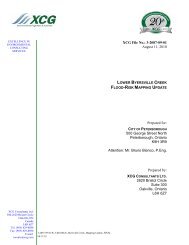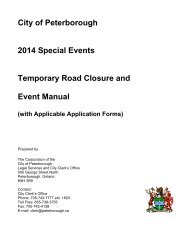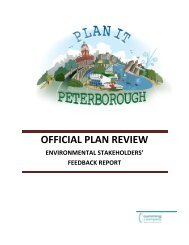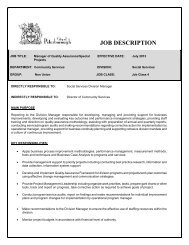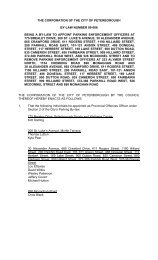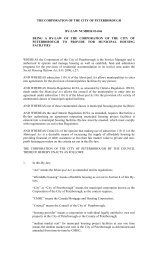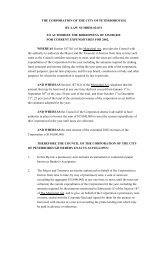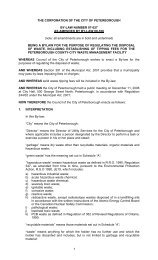Thompson Creek Flood Study Report - City of Peterborough
Thompson Creek Flood Study Report - City of Peterborough
Thompson Creek Flood Study Report - City of Peterborough
You also want an ePaper? Increase the reach of your titles
YUMPU automatically turns print PDFs into web optimized ePapers that Google loves.
<strong>Thompson</strong> <strong>Creek</strong> Detailed <strong>Flood</strong> Reduction <strong>Study</strong><br />
<strong>City</strong> <strong>of</strong> <strong>Peterborough</strong><br />
In order to use these rainfall volumes in the hydrologic models (OTTHYMO and<br />
OTTSWMM), they had to be transformed into volume-time distributions (hyetographs)<br />
as in the case <strong>of</strong> the July 2004 storm. To do this, it was agreed that a rainfall<br />
distribution pattern developed by Canada’s Atmospheric Environment Service (AES)<br />
would be used. This distribution, known colloquially as the “AES distribution,” was<br />
prepared by that federal agency by analysing the hyetographs <strong>of</strong> historical storms across<br />
Canada. Different distributions are available for each part <strong>of</strong> the country since storm<br />
types vary by location. Different distributions are also available depending upon the<br />
duration <strong>of</strong> the storm required. It was agreed (see Appendix K) that the 6 hour<br />
distribution would be the primary choice for the detailed flood reduction studies but that<br />
the 1 hour and 12 hour distributions would also be considered to determine which was<br />
most critical. The critical duration <strong>of</strong> a design storm depends upon the size <strong>of</strong> the<br />
watershed to which it is being applied. In the case <strong>of</strong> the <strong>Thompson</strong> <strong>Creek</strong> study area,<br />
the drainage area is relatively small (approximately 200 hectares). Hence it was<br />
anticipated that either the 1 hour or 6 hour distribution would be appropriate. Figure<br />
4.5.4 shows typical hyetographs for the 1 hour and 6 hour storms (based upon the 120<br />
mm event). It should be noted that the 193 mm event is actually the “Regional Storm”<br />
currently in use in the <strong>Peterborough</strong> area. It is based upon a historical event which<br />
occurred in Timmins, Ontario and has its own prescribed hyetograph shape. This is<br />
also shown on Figure 4.5.4. The six design storms used for flood limit mapping were<br />
based upon these patterns with the actual amounts adjusted to reflect the required totals.<br />
The actual amounts are tabulated in Appendix K.<br />
Figure 4.5.4: Hyetographs for Selected Rainfalls<br />
30<br />
25<br />
Rain (mm)<br />
20<br />
15<br />
10<br />
5<br />
0<br />
30<br />
60<br />
90<br />
0<br />
120<br />
150<br />
180<br />
210<br />
240<br />
270<br />
300<br />
330<br />
Time (min)<br />
360<br />
390<br />
420<br />
450<br />
480<br />
510<br />
540<br />
570<br />
600<br />
630<br />
660<br />
690<br />
720<br />
120 mm AES Type 2 (6 hr) 120 mm AES Type 2 (1hr) 193 mm - Timmins (12 hr) 100 Year AES Type 2 (6hr)<br />
14-06605-01-W01 <strong>City</strong> <strong>of</strong> <strong>Peterborough</strong> 57






